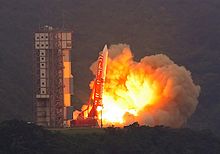 The fifth M-V launches with the ASTRO-EII spacecraft. | |
| Function | All-solid small orbital launch vehicle |
|---|---|
| Manufacturer | Nissan Motors[1] (-2000) IHI AEROSPACE (-2006)[2] |
| Country of origin | Japan |
| Size | |
| Height | 30.8 m (101 ft) |
| Diameter | 2.5 m (8 ft 2 in) |
| Mass | 137,500–139,000 kg (303,100–306,400 lb) |
| Stages | 3 or 4 |
| Capacity | |
| Payload to low Earth orbit | |
| Mass | 1,800 kg (4,000 lb) |
| Payload to polar LEO | |
| Mass | 1,300 kg (2,900 lb) |
| Launch history | |
| Status | Retired |
| Launch sites | Uchinoura M-V |
| Total launches | 7 (M-V: 4, M-V KM: 3) |
| Success(es) | 6 (M-V: 3, M-V KM: 3) |
| Failure(s) | 1 (M-V) |
| First flight | M-V: 10 February 2000 M-V KM: 12 February 1997 |
| Last flight | M-V: 22 September 2006 M-V KM: 9 May 2003 |
| Type of passengers/cargo | HALCA, Nozomi, ASTRO-E, Hayabusa Suzaku, AKARI Hinode |
| First stage – M-14 | |
| Powered by | 1 solid |
| Maximum thrust | 3,780.345 kN (849,855 lbf) |
| Specific impulse | 246 s (2.41 km/s) |
| Burn time | 46 seconds |
| Propellant | Solid |
| Second stage – M-24 | |
| Powered by | 1 solid |
| Maximum thrust | 1,245.287 kN (279,952 lbf) |
| Specific impulse | 203 s (1.99 km/s) |
| Burn time | 71 seconds |
| Propellant | Solid |
| Third stage – M-34 | |
| Powered by | 1 solid |
| Maximum thrust | 294 kN (66,000 lbf) |
| Specific impulse | 301 s (2.95 km/s) |
| Burn time | 102 seconds |
| Propellant | Solid |
| Fourth stage (M-V KM) – KM-V1 | |
| Powered by | 1 solid |
| Maximum thrust | 51.9 kN (11,700 lbf) |
| Specific impulse | 298 s (2.92 km/s) |
| Burn time | 73 seconds |
| Propellant | Solid |
The M-V rocket, also called M-5 or Mu-5, was a Japanese solid-fuel rocket designed to launch scientific satellites. It was a member of the Mu family of rockets. The Institute of Space and Astronautical Science (ISAS) began developing the M-V in 1990 at a cost of 15 billion yen. It has three stages and is 30.7 m (101 ft) high, 2.5 m (8 ft 2 in) in diameter, and weighs about 140,000 kg (310,000 lb). It was capable of launching a satellite weighing 1,800 kg (4,000 lb) into an orbit as high as 250 km (160 mi).
The first M-V rocket launched the HALCA radio astronomy satellite in 1997, and the second the Nozomi Mars explorer in July 1998. The third rocket attempted to launch the Astro-E X-ray satellite on 10 February 2000 but failed. ISAS recovered from this setback and launched Hayabusa to 25143 Itokawa in 2003. The following M-V launch was the scientific Astro-E2 satellite, a replacement for Astro-E, which took place on 10 July 2005. The final launch was that of the Hinode (SOLAR-B) spacecraft, along with the SSSat microsat and a nanosatellite, HIT-SAT, on 22 September 2006.
- ^ Travis S. Taylor (2009). Introduction to Rocket Science and Engineering. CRC Press. p. 25. ISBN 978-1-4200-7529-8.
- ^ "Projects&Products". IHI AEROSPACE. Archived from the original on 6 April 2011. Retrieved 8 March 2011.